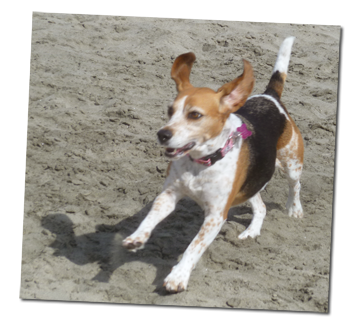Dogs in Santa Cruz...
I will be adding to this on an ongoing basis. Please email me with any questions.
Statistics
Click HERE
for statistics about Santa Cruz County dogs...
How many dogs? How many are licensed?
How much off-leash space? How much do dog owners pay in taxes/licenses?
Who are dog owners? Health benefits of dogs.
Why off-leash dog parks?
Important Reports for Your Proposal
Click HERE
for reports and information about dogs, wildlife, etc.
You will want to use these reports when fighting to get off-leash areas.

County Maps
What is private, what is county-owned along our beaches?
SEASCAPE
Please email me for the rest of the maps.
Who do I contact to get
an off-leash area?
Click HERE for contact info and meetings for the County, City and by the Parks Departments
Ideas to promote responsible pets in your community
HERE
Frequently mistaken ideas about off-leash dogs
Click on the statement to see the facts...
Dog owners want to take over the beach.
Dogs should not be allowed to run off-leash.
It is against federal and state laws to be off-leash.
Off-leash dogs can be dangerous and aggressive.
You are more likely to be bit by a dog you don't know.
The number of dog bites is increasing.
Dogs chase birds and are harmful to other wildlife.
Dogs can bother and affect the safety of other beach users.
Children are at high risk to be bit by an off-leash dog.
Dogs are harmful to children and they spread disease. NEW INFO!
Dog poop spreads bacteria and disease.
Why don't you just run with your dog on-leash?
Off-leash dogs will get lost or hurt.
Dogs should not be kept in captivity and should be sent back to the wild.
Frequently mistaken ideas about off-leash dogs
Dog owners want to take over the beach.
Actually, dog owners are asking to SHARE the beach.
Here are a few of the ideas that are working in existing off-leash beaches in California.
DESIGNATED SPACE
Allowing off-leash dogs in a section of a larger beach. With 27 miles of beach in Santa Cruz County, it seems reasonable to have a few off-leash sections. After all, we are 41% of the population and we pay taxes.
DOG HOURS
"Dog hours" are usually before 10am and after 4pm.
These are the hours the beaches are traditionally used less.
SEASONAL
Beach use in the off-season (non-summer) months.
Dogs should not be allowed to run off-leash.
Off-leash dog parks are good for dogs, their owners, and the whole community.
Dogs kept on leash all the time when outside tend to be more territorial, more aggressive, less friendly, and more prone to negative social behavior than dogs who are allowed opportunities to spend at least a few hours each week outdoors and off-leash.
Dogs who are allowed outdoor off-leash time on a regular basis tend to be calmer, better trained, better socialized, less prone to aggression, and add to the quality of life in the communities where they live.
Off-leash dog parks:
- Promote good canine physical health and socialization, reducing nuisance behaviors and making dogs better canine citizens.
- Discourages delinquent and criminal activity by humans in parks.
- Encourages people to exercise and stimulate social interaction with other people.
- Accommodates senior citizens and the disabled, who cannot always physically walk their dogs on-leash.
- Builds a community of people committed to parks, community involvement and the environment.
- Encourages compliance with local leash laws and reduces the number of dogs in shelters.
http://www.nycoffleash.com/html/index2.htm
It is against federal and state laws to be off-leash.
Dogs are allowed off-leash in national forests.
In the GGNRA (Golden Gate National Recreation Area), dogs are allowed off-leash and under voice control in these areas (excluding any wildlife areas):
-
Marin County
Alta Ave. between Marin City/Oakwood Valley, Muir Beach, Oakwood Valley Fire Road, and Oakwood Valley Trail from junction with Oakwood Valley Road to Alta Avenue, Homestead Valley, Rodeo Beach and South Rodeo Beach, Coastal Trail from Golden Gate Bridge to junction with Wolf Ridge Trail; Loop Trail from Rodeo Beach parking lot up Coastal Trail paved road (Old Bunker Road) near Battery Townsley and return to Rodeo Beach on paved road; Wolf Ridge Loop (Coastal Trail to Wolf Ridge Trail; Wolf Ridge Trail to Miwok Trail; Miwok Trail back down to Coastal Trail).
- San Francisco
Baker Beach, north of Lobos Creek , Crissy Field, Fort Funston, Fort Miley, Lands End, Ocean Beach.
National Forests
Dogs allowed off-leash and under voice control on the trails.
Must be on-leash in campgrounds.
California State Beaches
There is one off-leash dog beaches owned by the state:
Long Beach.
Off-leash dogs can be dangerous and aggressive.
A study of 17 California dog parks conducted by Melissa Bain, from UC Davis School of Veterinary Medicine, concluded that injuries to people from dog bites in off-leash areas are rare.
Jean Donaldson, the founder and director of the SF/SPCA Dog Training Academy with over 30 years experience in dog behavior and training, and the author of several books. Donaldson said:
“There is not only no evidence that allowing dogs off-leash for play opportunities increases the incidence of aggression, every reputable expert in the field of dog behavior in the United States is of the opinion that it is likely that off-leash access decreases the likelihood of aggression.”
Kathy Santo, a nationally recognized dog trainer, has said “I strongly believe that it is good, or more accurately necessary for healthy dogs to play off-leash in safe areas while supervised by their owners. An exercised, socialized dog is a happy and well-adjusted dog.”
A research paper was published in 2003 in the Journal of Applied Animal Welfare Science which looked at the prevalence of interdog aggression in dog parks. Dog-dog problems turned out to be minimal and of a non-serious nature. While the paper did not consider the question of dog-to-human aggression, the obvious interpretation of this low incidence of aggression was interesting and I think very relevant. They suggested that self-selection operates strongly, i.e., people who take their time to get into their car or walk to a designated off-leash area to exercise their dog tend to not to be the type who are derelict in other areas of dog guardianship, such as training, socialization or appropriate containment.
LIABILITY
The 2006 publication: "Dogs on the Beach: A Review of Regulations and Issues Affecting Dog Beaches in California" conducted a survey of beach managers and found no examples of lawsuits at any dog beaches in the state. Signage at most dog parks and beaches announces to visitors that they enter the areas at their own risk.
You are more likely to be bit by a dog you don't know.
The chance of being bitten in a park by a strange dog that you have not interacted with is pretty slim.
Consider where dog bites rank in the context of accidental injuries for people in general. According to the Centers for Disease Control’s WISQAR (Web-based Injury Statistics Query and Reporting System that tracks injuries treated in hospital emergency rooms), accessible at:
National Accident Statistics
The top 5 causes of accidental injury in the United States in 2006 were:
1. Fall 28.7%
2. Struck by/against an object (not a vehicle) 16.9%
3. Over exertion 12.6%
4. Occupant in motor vehicle 9.8%
5. Cut/pierce/stab 8%
Dog bites are #14 and 1.1% of accidents.
So you are TEN TIMES more likely to have an accident on the way to the beach, than to be bit by a dog on the beach.
The number of dog bites is increasing.
We suffer much more violence from each other than we do from dogs.
~ National Canine Research Council
Reports of dog bites to public health agencies have declined significantly since the 1970's. Even the United States Postal Service, whose letter carriers have always had high exposures to dogs, reports dramatic decreases in dog bite-related injuries over the past decades. In 1970, the Postal Service told the news media that more than 10,000 letter carriers were bitten each year by dogs. In 2010, Postal Service employees suffered fewer than 2,700 OSHA-reportable dog-related injuries.
Los Angeles has seen the number of reported dog bites decrease from well over 40,000 per year in the 1970s to less than 6,000 per year during past three years. (In 1975, the population of Los Angeles was approximately 2.9 million. By 2006, the population had grown to 3.85 million.)
Dogs chase birds and are harmful to other wildlife.
A 2006 study by Forrest and Cassady St. Clair studied diversity and abundance of bird and small mammals at 56 sites in urban parks in Edmonton, Alberta. Half of the sites were visited by off-leash dogs, half were on-leash or no dogs. City officials reported the on-leash sites had high public compliance with leash laws.
To their surprise, they discovered that whether a site was on- or off-leash had “no measurable effect on the diversity or abundance of birds and small mammals.”
This lack of difference between on- and off-leash sites was seen even when with species that appeared to be breeding, or only those that nested on the ground or in low shrubs.
Even studies conducted in the GGNRA itself indicate that dogs have no significant negative impact on the population of snowy plovers at Ocean Beach.
The 1996 report “Western Snowy Plover (a Federally Threatened Species) Wintering Population and Interaction with Human Activity on Ocean Beach, San Francisco, GGNRA, 1988 through 1996” by Daphne Hatch found that there was an increase of more than 100% in the number of snowy plovers in the years after the 1979 Pet Policy went into effect (allowing dogs off-leash on Ocean Beach and elsewhere).
Hatch could not find any negative relationship between the number of dogs on the beach at a given time and the number of plovers on the beach at the same time.
Indeed, the 1996 Hatch Report states: “Factors other than the number of people or dogs, possibly beach slope and width, appear to exert greater influence over Snowy Plover numbers on Ocean Beach.”
According to the California State Parks 2002 publication
Rules & Guidelines for Protecting the Snowy Plover,
it is “human use of their remaining beach habitat seriously threatens their survival”.
This brochure suggests guidelines that include:
no kite flying, no frisbees, no bonfires, no fireworks, no picnicing, and no sunbathing.
Dogs can bother and affect the safety of other beach users.
Dogs do not represent a major safety problem for other park visitors that would require restrictions on off-leash recreation to correct.
Of course, dogs should never bother other visitors. Proper Petiquette is to not let your dog approach people you do not know. Dogs should not jump on people, or take food away from them.
Dog training and public education can address these problems.
It is not necessary to restrict off-leash recreation to address these issues.
Many people, especially women and seniors, do not feel safe hiking alone in GGNRA without a dog.
Children are at high risk to be bit by an off-leash dog.
In one of the most comprehensive analyses of injuries due to dog bites, Canadian researchers searched a national database of all reports of injuries throughout Canada in 1996 (Canadian Hospitals Injury Reporting and Prevention Program, or CHIRPP; the study can be found at:
CHIRPP study
Dog bites represented 1% of all injuries in the CHIRPP database.
The CHIRPP analysis found that children between 2 and 14 years of age sustained over 70% of all bites. Most of the dogs involved in bite incidents (65.2%) were either part of the family, part of the extended family, or part of a friend or neighbor’s family. Only 12.2% were stray or unfamiliar dogs. The majority of the dog bites (64.5%) happened in someone’s home (either the victim’s or another person’s home).
Only 3.1% of dog bites occurred in a public park.
Jean Donaldson, the founder and director of the SF/SPCA Dog Training Academy said:
Off-leash play has not proven to be a factor in dog bites. According to both the Centers for Disease Control and Prevention and the American Veterinarian Medical Association, the majority of bites take place on the guardians’ property. The remaining incidents involve dogs that are either restrained, i.e., leashed, or dogs that are “at large”, [that is,] unsupervised dogs that have escaped confinement.
Dogs are harmful to children.
NEW INFO!
A new study (June 2012) by Dr. Kei Fujimura at UCSF shows that having a dog protects kids from common viral infections and LOWER a child's chance of developing asthma. Read the study HERE.
According to Pete Wedderburn, veterinarian, studies have shown that children who grow up around animals develop into more confident, socially adept individuals. Animals can help to teach children valuable social skills during a critical time in their psychological development. Children treat pets as their friends, and in the absence of verbal communication, they learn to use body language to understand each other. If a child learns to understand the body language of their pet, they will naturally extend that knowledge to have a better understanding of human body language in other situations later in life.
Safety tips for children
To help prevent children from being bitten by dogs, teach the following basic safety tips and review them regularly:
• Do not approach an unfamiliar dog.
• Do not run from a dog or scream.
• Remain motionless (e.g., "be still like a tree") when approached by an unfamiliar dog.
• If knocked over by a dog, roll into a ball and lie still (e.g., "be still like a log").
• Do not play with a dog unless supervised by an adult.
• Immediately report stray dogs or dogs displaying unusual behavior to an adult.
• Avoid direct eye contact with a dog.
• Do not disturb a dog that is sleeping, eating, or caring for puppies.
• Do not pet a dog without allowing it to see and sniff you first.

Dog poop spreads bacteria and disease.
Here are links to current water quality
at Santa Cruz beaches.
As you can see, those beaches that have
off-leash dogs do NOT score higher.
In fact, they are some of the lowest in the county.
Current Water Qualty
Current Water Quality Chart
There has not been a single case of
dog-feces borne illness in a human
reported to the San Francisco Department
of Public Health in over 50 years.
Why don't you just run with your dog on-leash?
Dogs need to run.
Dogs average 19mph running. Greyhounds can run up to 42mph.
The average human runs 11mph.
Off-leash dogs will get lost or hurt.
Tens of thousands of dogs visit the GGNRA every day.
Analysis of incidents in the GGNRA from 2001 to 2006:
Dog safety in GGNRA
Dogs should not be kept in captivity and should be sent back to the wild.
Dogs have been domesticated for at least 15,000 years and we have a symbiotic relationship with them that benefits us both.
|






